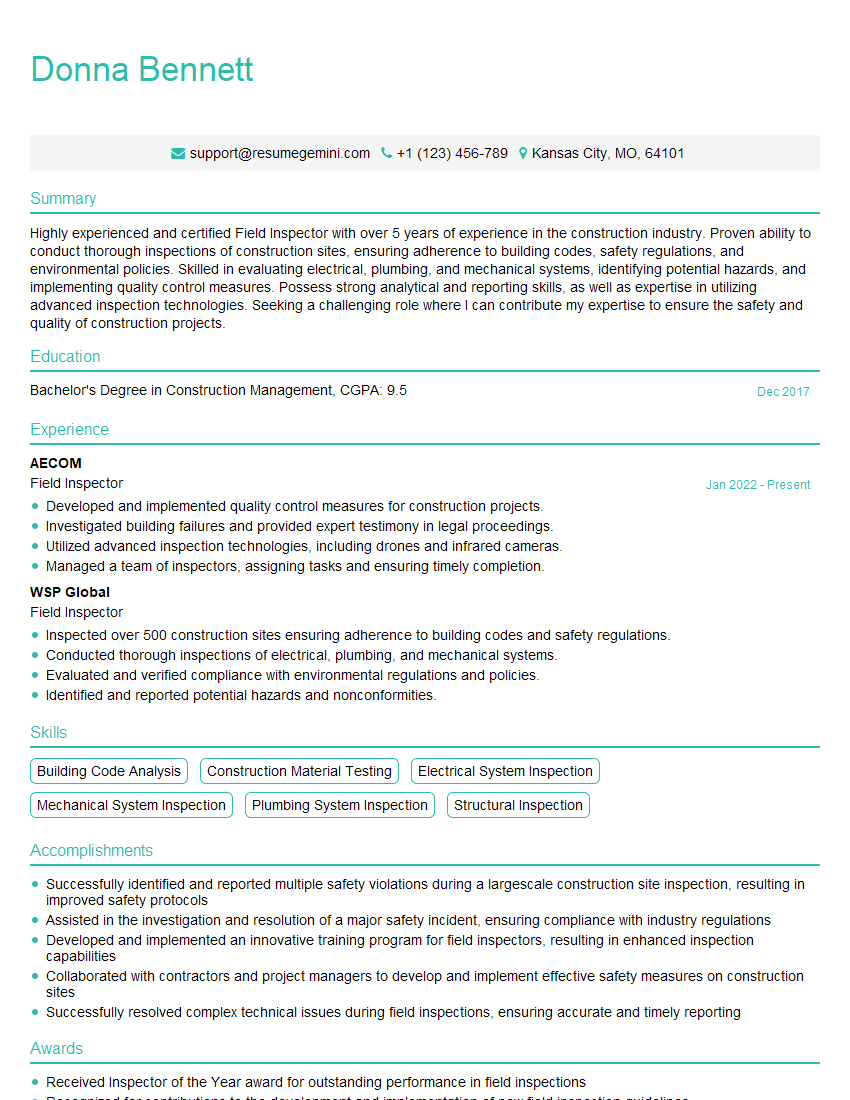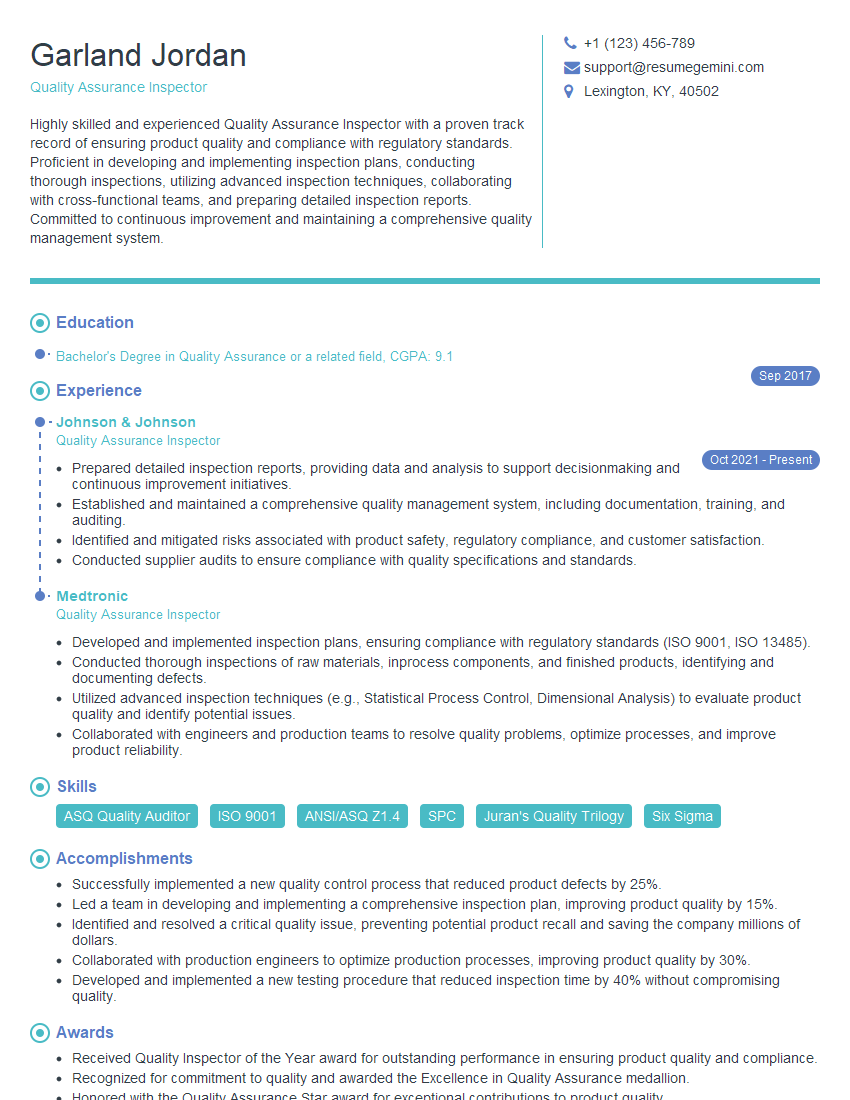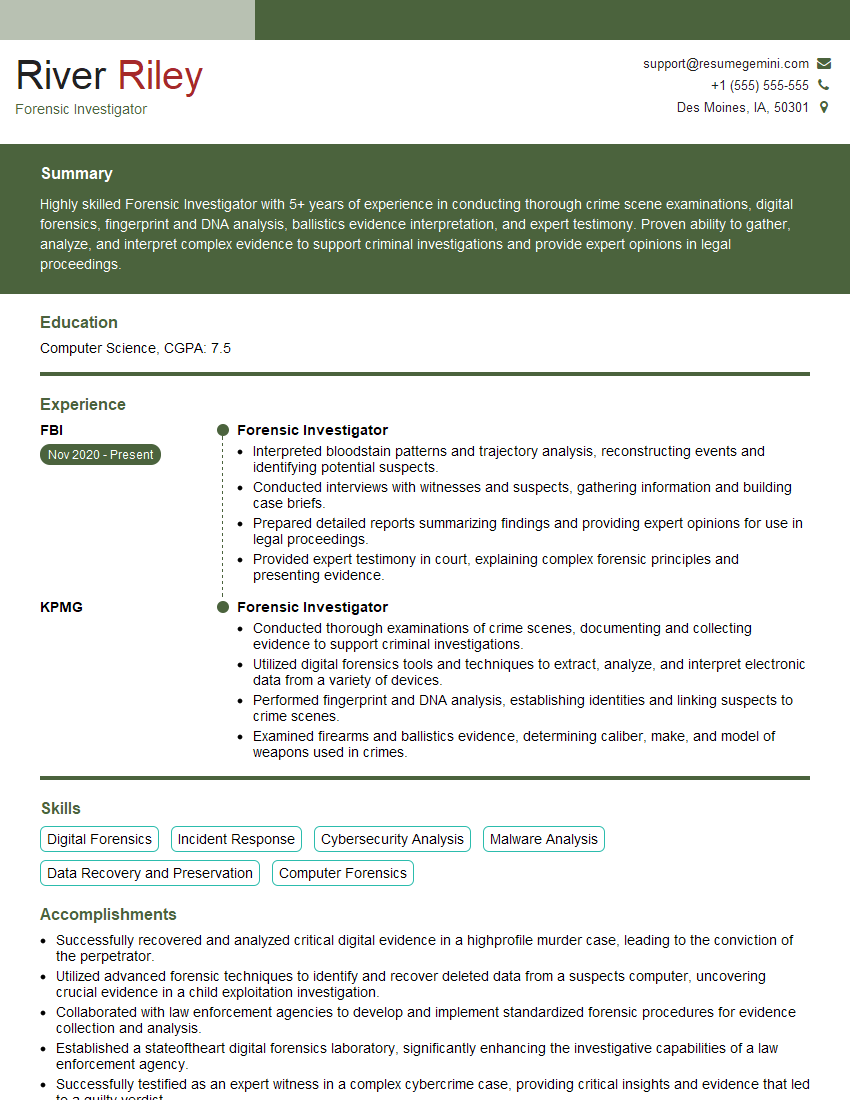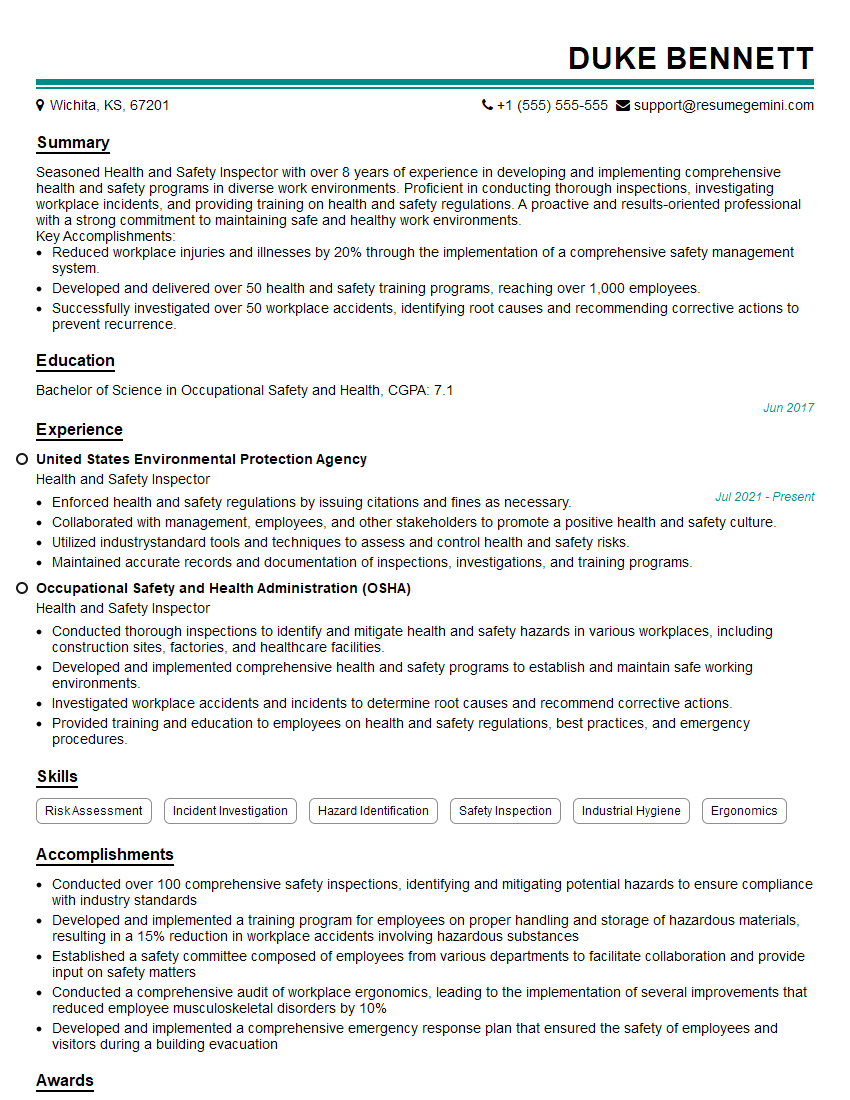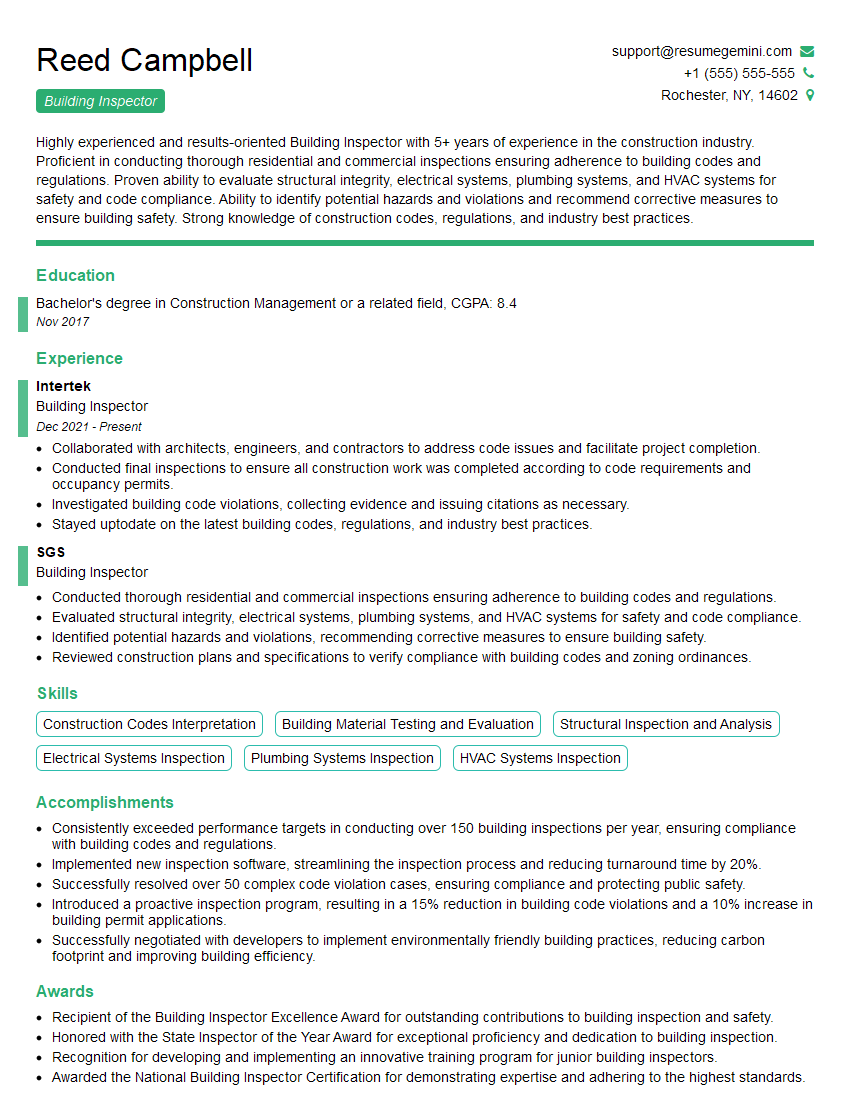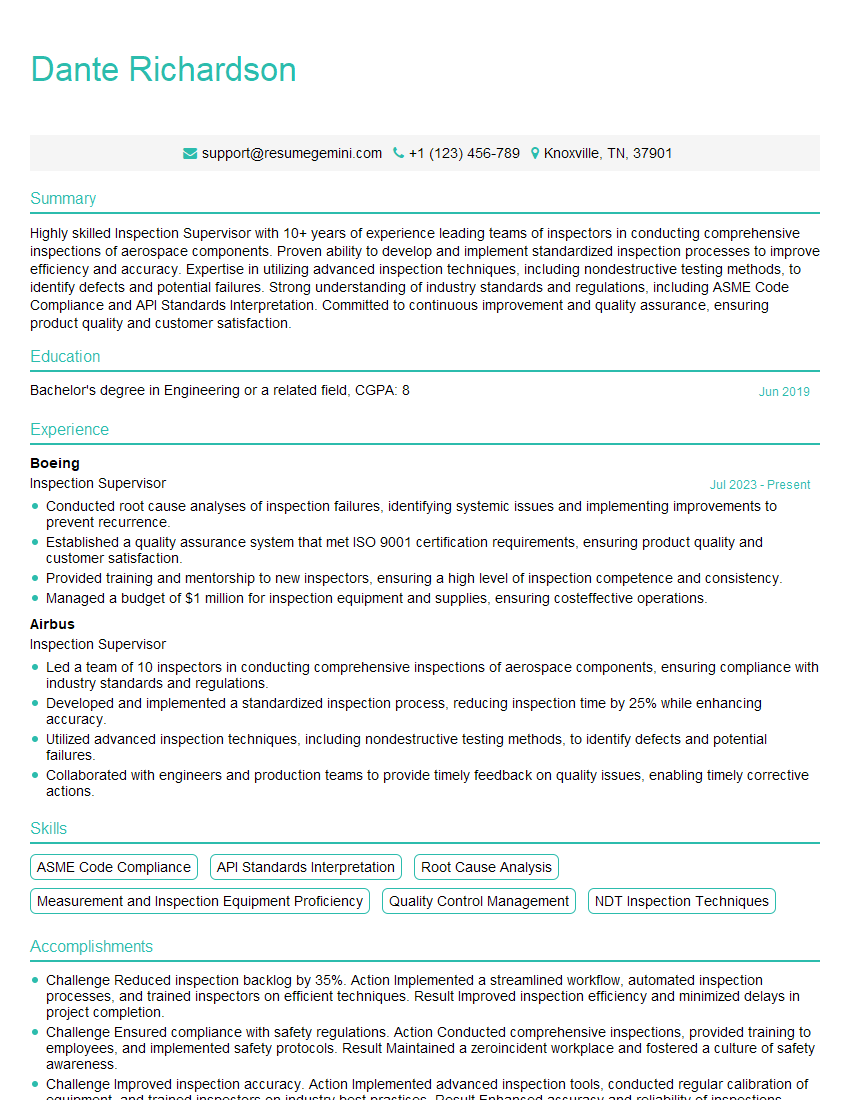Feeling uncertain about what to expect in your upcoming interview? We’ve got you covered! This blog highlights the most important Inspection and Surveillance interview questions and provides actionable advice to help you stand out as the ideal candidate. Let’s pave the way for your success.
Questions Asked in Inspection and Surveillance Interview
Q 1. Describe your experience with different inspection methods (visual, non-destructive testing, etc.).
My experience encompasses a wide range of inspection methods, from basic visual inspections to sophisticated non-destructive testing (NDT) techniques. Visual inspection forms the foundation, allowing me to identify readily apparent defects like cracks, corrosion, or misalignments. Think of it like a thorough visual examination of a car before purchase – you’re looking for obvious dents, scratches, or fluid leaks. However, visual inspection alone is often insufficient. That’s where NDT comes in.
I’m proficient in several NDT methods, including:
- Ultrasonic Testing (UT): Uses high-frequency sound waves to detect internal flaws in materials. Imagine it like a medical ultrasound, but for industrial components. I’ve used UT extensively to inspect welds in pipelines and pressure vessels, identifying potential weaknesses before they become catastrophic failures.
- Radiographic Testing (RT): Employs X-rays or gamma rays to create images of internal structures. This is excellent for detecting hidden porosity or inclusions in castings. Think of it like a medical X-ray, providing a detailed internal view of the object.
- Magnetic Particle Testing (MT): Uses magnetic fields to detect surface and near-surface cracks in ferromagnetic materials. It’s akin to using a magnet to find tiny metal particles that indicate cracks. I’ve used this effectively when inspecting components subject to cyclic loading, such as aircraft parts.
- Liquid Penetrant Testing (PT): This method is ideal for finding surface cracks in non-porous materials. A dye penetrates cracks, then a developer draws it out, making the cracks visible to the naked eye. It’s a simple yet powerful technique for identifying surface defects on a variety of components.
The choice of inspection method depends heavily on the material being inspected, the type of defect being sought, and the accessibility of the component.
Q 2. Explain your understanding of quality control standards (ISO 9001, etc.).
My understanding of quality control standards, particularly ISO 9001, is comprehensive. ISO 9001 is an internationally recognized standard that outlines requirements for a quality management system (QMS). It’s essentially a framework for ensuring consistent product quality and customer satisfaction. A QMS guided by ISO 9001 helps organizations establish processes for planning, controlling, monitoring, and continuously improving their products and services.
In my work, I apply ISO 9001 principles by:
- Following documented procedures: Each inspection task adheres to pre-defined, documented procedures, guaranteeing consistency and traceability.
- Maintaining accurate records: All inspection findings, including deviations and corrective actions, are meticulously documented. This is crucial for audits and demonstrating compliance.
- Using calibrated equipment: All inspection equipment is regularly calibrated to ensure accuracy and reliability, avoiding measurement errors that might compromise product quality.
- Participating in internal audits: I actively contribute to internal audits to identify areas for improvement within the QMS.
Beyond ISO 9001, I’m also familiar with other industry-specific standards and regulations, adapting my approach to meet the unique requirements of each project.
Q 3. How do you handle discrepancies found during an inspection?
When discrepancies are found during an inspection, my approach is methodical and focuses on thorough investigation and clear communication. The process involves several key steps:
- Careful Documentation: I meticulously document the discrepancy, including its location, nature, severity, and any relevant photographs or measurements. This provides a clear record of the findings.
- Root Cause Analysis: I attempt to identify the root cause of the discrepancy, going beyond simply identifying the defect itself. This might involve reviewing manufacturing processes, material specifications, or operator training records.
- Risk Assessment: I evaluate the risk associated with the discrepancy. This assessment considers factors like the severity of the defect and its potential impact on product safety or performance.
- Communication: I promptly communicate the discrepancy and my findings to the relevant stakeholders, including manufacturing personnel, quality control managers, and clients. Open communication prevents misunderstandings and ensures everyone is informed.
- Corrective Action Plan: Based on the root cause analysis and risk assessment, I help develop a corrective action plan to address the discrepancy and prevent similar issues from recurring. This might include process changes, material replacements, or additional training.
- Follow-up: I follow up on the implementation of the corrective action plan and verify its effectiveness. This ensures that the problem is truly resolved.
For example, if I discovered a weld defect during an inspection of a pressure vessel, I wouldn’t just report the defect; I would investigate why it occurred (perhaps improper welding technique or substandard materials), assess the risk (potential leakage or vessel failure), communicate my findings, propose solutions (retraining welders, material testing), and follow up to confirm the corrective actions were implemented effectively.
Q 4. What are your skills in using inspection equipment (e.g., calipers, micrometers)?
I possess a high level of proficiency in using various inspection equipment, including calipers, micrometers, dial indicators, and other precision measuring instruments. My experience extends to using both analog and digital versions of these tools. I understand the principles of measurement error and uncertainty and take steps to minimize them. For instance, I always check for zero error in the measuring instrument before any measurement and repeat measurements to improve accuracy.
My skills in using these tools are not simply about obtaining measurements. They involve understanding their limitations, selecting the appropriate tool for the job, and interpreting the results in the context of the specific application and relevant standards. I’m also familiar with the proper maintenance and calibration procedures for these instruments, ensuring that their accuracy is consistently maintained. For example, if I’m inspecting the dimensions of a machined part, I’d select the appropriate caliper or micrometer based on the precision required, ensuring I carefully maintain proper technique to minimize measurement error.
Q 5. Describe your experience with report writing and documentation related to inspections.
My experience with report writing and documentation is extensive. I understand the importance of creating clear, concise, and comprehensive reports that accurately reflect the inspection findings and support any subsequent decision-making. My reports typically include:
- Detailed descriptions of the inspection process: This includes the methods used, the equipment employed, and any limitations encountered.
- Clear presentation of findings: I use tables, graphs, and photographs to clearly present the data and highlight any discrepancies or non-conformances.
- Objective analysis and interpretation: My interpretations are based on factual findings and avoid subjective judgments. I avoid technical jargon unless it’s properly defined and essential for understanding.
- Recommendations for corrective actions: I often include recommendations for addressing any identified defects or deficiencies.
- Compliance with relevant standards: My reports consistently comply with relevant standards and regulatory requirements.
I’m adept at utilizing various software for report generation, including Microsoft Word, Excel, and specialized inspection software packages. My reports are designed for clarity and ease of understanding, regardless of the audience’s technical expertise. For instance, when reporting on the inspection of a bridge, my report wouldn’t be overloaded with engineering jargon – instead, I’d use plain language to describe defects, their potential impact, and any recommended remedial actions.
Q 6. How do you prioritize multiple inspection tasks with competing deadlines?
Prioritizing multiple inspection tasks with competing deadlines requires a strategic approach. I utilize a framework that combines task analysis, risk assessment, and resource allocation. The process includes:
- Task Prioritization Matrix: I create a matrix that lists all tasks, their deadlines, and associated risks (severity of consequences if delayed). High-risk, short-deadline tasks receive top priority.
- Time Estimation and Resource Allocation: I realistically estimate the time required for each task, considering available resources and potential disruptions. This helps ensure realistic scheduling.
- Scheduling and Sequencing: I employ scheduling techniques (e.g., critical path method) to determine an optimal sequence of tasks, aiming for efficient resource utilization and minimizing delays. I communicate my prioritization to stakeholders.
- Regular Monitoring and Adjustments: I continuously monitor progress, adapting the schedule and resource allocation as needed based on unexpected events and changing priorities. This ensures responsiveness to dynamic situations.
Essentially, I treat prioritizing tasks like managing a project. By systematically analyzing each task’s urgency and importance, combined with realistic time management and resource allocation, I can effectively manage competing deadlines and ensure the timely completion of critical inspections.
Q 7. What software or tools are you proficient in for data analysis in surveillance?
My proficiency in data analysis software extends to several tools used for surveillance and inspection data management and interpretation. I’m proficient with:
- Microsoft Excel: For data entry, organization, and basic statistical analysis. I routinely utilize charting and data visualization techniques to illustrate trends and patterns in inspection data.
- Statistical Software Packages (e.g., Minitab, SPSS): For advanced statistical analysis, such as regression analysis, control charting, and hypothesis testing, allowing for a more in-depth understanding of the data.
- Database Management Systems (e.g., Access, SQL): To manage large volumes of inspection data, facilitate data queries, and support reporting and trend analysis.
- Specialized Inspection Software: I’m familiar with various software packages specifically designed for managing and analyzing inspection data from NDT equipment. These tools often offer advanced capabilities for data visualization and report generation.
The choice of software depends on the complexity of the data and the nature of the analysis required. For example, a simple visual inspection might only require Excel, whereas a complex NDT inspection might necessitate specialized software for data analysis and report generation. My ability to effectively utilize these tools allows me to extract meaningful insights from inspection data, identify trends, and facilitate data-driven decision making in surveillance activities.
Q 8. Explain your understanding of different surveillance technologies (CCTV, video analytics, etc.).
Surveillance technologies encompass a range of tools designed to monitor and record activities. Closed-Circuit Television (CCTV) is the most basic, using cameras to capture visual data. This data is then transmitted to a central location for viewing and recording. However, simply recording footage isn’t enough in today’s world. Video analytics significantly enhance CCTV by adding intelligence. These systems employ sophisticated algorithms to analyze video feeds in real-time, identifying specific events, objects, or behaviors.
- CCTV: Think of traditional security cameras in a store or bank. They record everything within their field of view.
- Video Analytics: Imagine a system that automatically alerts security personnel if it detects a person leaving a designated area without authorization, or identifies a suspicious object left unattended. This goes beyond simple recording, providing proactive security measures. Specific examples include facial recognition, license plate recognition, and intrusion detection.
- Other technologies: Beyond CCTV and video analytics, other surveillance technologies include thermal imaging, which detects heat signatures, and acoustic sensors, which detect unusual sounds. The integration of these different technologies often enhances the overall security and monitoring capabilities.
Q 9. How do you ensure the confidentiality and security of surveillance data?
Confidentiality and security of surveillance data are paramount. This involves a multi-layered approach. First, access to the data needs to be strictly controlled. Only authorized personnel should have viewing and management permissions. This is implemented through robust user authentication and authorization systems, often with role-based access control (RBAC).
Secondly, data needs to be encrypted both in transit and at rest. Encryption ensures that even if the data is intercepted, it remains unreadable without the decryption key. Regular security audits and penetration testing are essential to identify and fix vulnerabilities. We also need to comply with data retention policies, ensuring data is only kept for the necessary period and then securely destroyed. Finally, physical security of the recording equipment and servers is crucial. This could involve secure rooms with access controls, and backup systems in case of physical damage or theft. Think of it like a bank vault – multiple layers of security for maximum protection.
Q 10. Describe your experience with interpreting surveillance footage and identifying anomalies.
Interpreting surveillance footage requires meticulous observation and attention to detail. It’s not just about watching the video; it’s about understanding context. I begin by reviewing the metadata – date, time, camera location – to establish a baseline. Then, I carefully analyze the visual elements, searching for patterns or deviations from the norm. For example, if I’m monitoring a warehouse, I’d look for unusual movements, unauthorized entry, or objects placed in unexpected locations. Identifying anomalies requires experience and knowledge of the specific environment. What might seem normal in one setting could be highly suspicious in another. I often use techniques like slow-motion playback and zooming in to highlight details that could otherwise be missed.
In one case, I identified a theft by noticing a subtle change in a worker’s gait after accessing a restricted area. That small detail, combined with other circumstantial evidence, helped resolve the incident.
Q 11. How do you handle situations where surveillance equipment malfunctions?
Malfunctioning surveillance equipment is a significant concern. My first step is to identify the nature and extent of the malfunction. Is it a single camera, a network issue, or a problem with the recording server? Troubleshooting often involves checking cable connections, power supply, and network connectivity. Remote diagnostics can be helpful for identifying problems in networked systems. We also rely on system logs and alerts to pinpoint the source of the failure.
If the issue cannot be resolved remotely, on-site repairs or replacements might be necessary. Depending on the criticality of the system, we may have backup systems or redundant cameras in place to maintain coverage during repairs. It’s essential to document all malfunctions, repairs, and downtime to ensure accountability and improve future maintenance strategies. Regular preventative maintenance is key to minimizing equipment failures.
Q 12. What is your experience with different types of surveillance systems (IP, analog, etc.)?
I have extensive experience with both IP and analog surveillance systems. Analog systems use coaxial cables to transmit video signals, and generally require a DVR (Digital Video Recorder) for recording. They are generally more affordable but offer less flexibility and lower image quality compared to IP systems. IP systems, on the other hand, transmit video data over a network using IP addresses, often utilizing network video recorders (NVRs). This allows for easier scalability, remote access, and higher-resolution images. They offer advanced features like video analytics and integration with other security systems.
I’ve worked on projects involving both types of systems, understanding their strengths and limitations. My experience allows me to select the most appropriate system for a given situation, taking into account budget, security requirements, and the specific environment.
Q 13. How do you maintain compliance with relevant regulations and laws related to surveillance?
Compliance with regulations governing surveillance is critical. This varies widely by jurisdiction, but generally includes laws concerning data privacy, data protection, and the right to privacy. For example, in many places, the use of surveillance must be clearly communicated, and individuals must be informed that they are being monitored. Data retention policies need to be established and adhered to, respecting legal limits on how long data can be stored. Furthermore, surveillance footage should only be used for legitimate purposes, and unauthorized access or disclosure is a serious offense. Staying updated on these regulations and implementing appropriate policies and procedures is vital to avoid legal issues and maintain ethical standards.
Our team regularly undergoes training on relevant laws and best practices. We maintain detailed documentation of our surveillance operations, including policies and procedures, to ensure transparency and accountability. We conduct regular audits to verify our adherence to all relevant regulations.
Q 14. Describe your understanding of risk assessment related to inspection and surveillance.
Risk assessment in inspection and surveillance is a systematic process aimed at identifying and evaluating potential threats and vulnerabilities. This involves analyzing the likelihood and impact of various events. For instance, in a manufacturing facility, potential risks could include equipment malfunction leading to accidents, theft of materials, or cyberattacks disrupting operations. A thorough risk assessment would consider the consequences of each scenario (financial losses, safety hazards, reputational damage) and their probability of occurrence.
This assessment informs the development of security measures and mitigation strategies. It helps determine the type and placement of surveillance equipment, the level of security needed, and the frequency of inspections. For example, a high-risk area might require more frequent inspections and higher-resolution cameras with video analytics. The risk assessment is a dynamic process, updated regularly to reflect changes in the environment and technology.
Q 15. How do you identify and mitigate potential risks during an inspection or surveillance operation?
Identifying and mitigating risks during inspections and surveillance is a crucial aspect of ensuring safety and compliance. It involves a proactive and systematic approach that begins before the operation even starts.
- Pre-Inspection Risk Assessment: Before any on-site work, I meticulously review all available information, including site maps, previous inspection reports, and any known hazards. This allows me to anticipate potential problems and prepare accordingly. For example, if inspecting a chemical plant, I’d identify potential hazards like chemical spills, equipment malfunctions, and confined space entry risks.
- On-site Risk Mitigation: During the inspection, I continuously assess the environment and adjust my procedures as needed. This might involve using appropriate Personal Protective Equipment (PPE) like safety glasses or respirators, following established safety protocols, and immediately reporting any unsafe conditions. If I encounter an unexpected hazard—for instance, a damaged electrical line—I’d immediately halt the inspection, report it to the appropriate personnel, and ensure the area is secured.
- Post-Inspection Review: After completing the inspection, I review all findings and identify any areas where risks were mitigated successfully and those where improvements are needed. This feedback loop is essential for continuous improvement and minimizing future risks. A detailed report would include not just findings but also recommended preventative measures.
This multi-layered approach allows for proactive risk management, minimizing the likelihood of incidents and ensuring a safe working environment for myself and others.
Career Expert Tips:
- Ace those interviews! Prepare effectively by reviewing the Top 50 Most Common Interview Questions on ResumeGemini.
- Navigate your job search with confidence! Explore a wide range of Career Tips on ResumeGemini. Learn about common challenges and recommendations to overcome them.
- Craft the perfect resume! Master the Art of Resume Writing with ResumeGemini’s guide. Showcase your unique qualifications and achievements effectively.
- Don’t miss out on holiday savings! Build your dream resume with ResumeGemini’s ATS optimized templates.
Q 16. Explain your experience working with different stakeholders (clients, supervisors, etc.).
Working with diverse stakeholders is fundamental to successful inspection and surveillance. I’ve cultivated strong communication and collaboration skills through years of experience.
- Clients: I build rapport with clients by clearly outlining the scope of work, expectations, and timelines. I keep them regularly updated on progress and findings, ensuring transparency and open communication. For example, I’ve worked with clients who needed specific data points for insurance purposes; I tailored my reporting to directly address their needs.
- Supervisors: I maintain open communication with supervisors, keeping them informed of any challenges or changes in the inspection plan. I actively seek their guidance when needed, ensuring alignment with organizational objectives. This includes reporting any potential safety concerns promptly.
- On-site Personnel: Effective communication with on-site personnel is critical. I approach individuals with respect and professionalism, clearly explaining the purpose of the inspection and addressing any concerns they may have. For instance, I’ve had to explain complex regulations to plant operators in a way that they understand, ensuring cooperation and a smooth process.
My ability to adapt my communication style to different audiences ensures efficient collaboration and successful project outcomes.
Q 17. How do you communicate findings from inspections and surveillance effectively?
Effective communication of inspection findings is crucial for driving improvements and preventing future issues. I utilize several methods to ensure clarity and understanding.
- Clear and Concise Reporting: I prepare comprehensive reports that include a summary of findings, detailed observations, supporting evidence (photos, videos), and clear recommendations for corrective actions. I use plain language, avoiding unnecessary technical jargon.
- Visual Aids: I often incorporate visual aids, such as maps, diagrams, and photographs, to illustrate key findings and make the report easier to understand. This can be especially effective in highlighting specific locations of deficiencies.
- Presentations and Briefings: Depending on the audience and the complexity of the findings, I may deliver presentations or briefings to explain the results and answer questions. I tailor the presentation to the audience’s technical expertise and needs.
- Follow-up Communication: I always follow up on the report to ensure that corrective actions are implemented and to answer any questions or address concerns.
My goal is to ensure that the findings are not just understood but also acted upon to improve safety and compliance.
Q 18. Describe a situation where you had to solve a complex problem during an inspection.
During an inspection of a large manufacturing facility, I encountered a discrepancy in the safety protocols documented versus those actually practiced. The documented procedures appeared comprehensive, but observation revealed significant deviations.
I initially documented the discrepancies and interviewed multiple employees at different levels. The conflicting information pointed to a lack of proper training and oversight. A deeper investigation uncovered that the updated safety protocols weren’t adequately disseminated to the workforce, resulting in the observed inconsistencies.
To solve this, I presented a phased approach to the client: immediate remedial actions addressing the most critical safety concerns, a comprehensive retraining program, and implementation of a system for ensuring future compliance. This included recommendations for enhanced supervision and better communication channels for disseminating updates. The client adopted this solution, which successfully addressed the identified issues and improved overall safety.
Q 19. How do you manage conflicting information or data during an inspection?
Managing conflicting information requires a systematic and analytical approach. I use the following steps:
- Identify and Document Discrepancies: The first step is to meticulously document all conflicting information, noting the source and any supporting evidence. For example, if one document shows a system is updated, but my observation suggests otherwise, I document both.
- Verify Information: I attempt to verify the accuracy of each piece of information through independent sources or cross-referencing. This may involve reviewing additional documentation, interviewing personnel, or conducting further observations.
- Analyze Evidence: I analyze the available evidence to determine the most credible source of information. This analysis may involve considering the reliability of the sources, the level of detail, and any potential biases.
- Resolve Conflicts: Once the most credible information is identified, I incorporate that into the report, clearly explaining how the conflict was resolved and the rationale behind the decision. I note the unresolved conflicts as well, flagging them for further investigation.
This approach allows for a thorough and unbiased evaluation of the situation, resulting in a more accurate and reliable assessment.
Q 20. How familiar are you with incident reporting procedures related to security breaches or violations?
I am very familiar with incident reporting procedures, particularly those concerning security breaches or violations. My experience includes working with various reporting frameworks, including those mandated by regulatory bodies and industry best practices.
Typically, these procedures involve immediately securing the scene (if applicable), gathering relevant evidence, documenting the incident comprehensively, and reporting it through the appropriate channels in a timely manner. The details of the report usually include the nature of the breach, the individuals involved, the potential impact, and the corrective actions taken. Confidentiality and data privacy are paramount throughout the process. The specifics of each procedure vary greatly depending on the context—a data breach requires different protocols than a physical security breach—but the core principles remain the same.
Q 21. What is your experience with conducting internal investigations?
I have considerable experience conducting internal investigations, focusing primarily on incidents related to security breaches, non-compliance, and workplace misconduct. My approach follows a structured methodology emphasizing fairness, objectivity, and confidentiality.
This includes:
- Defining the Scope: Clearly outlining the objective, timeline, and areas of focus for the investigation.
- Gathering Evidence: Collecting relevant information through interviews, document reviews, and forensic analysis (as needed).
- Interviewing Witnesses: Conducting structured interviews with relevant individuals to gather their perspectives and insights.
- Analyzing Evidence: Critically evaluating the gathered evidence to determine the facts and reach conclusions.
- Preparing a Report: Documenting findings, conclusions, and recommendations in a clear, concise, and objective manner.
My approach prioritizes maintaining the integrity of the process while ensuring that all parties are treated fairly and respectfully. The ultimate goal is to identify root causes, implement corrective actions, and prevent similar incidents in the future.
Q 22. What are your skills in data analysis and interpretation of surveillance data?
My data analysis skills encompass a wide range of techniques applied to surveillance data, from basic descriptive statistics to advanced predictive modeling. I’m proficient in using software like SQL, Python (with libraries such as Pandas and Scikit-learn), and specialized analytics platforms to extract meaningful insights. For instance, I can analyze video footage to identify patterns in criminal behavior, such as typical routes or times of operation. I can also process sensor data from various sources – motion detectors, pressure sensors, etc. – to build comprehensive situational awareness models. I’m adept at identifying anomalies, correlating events, and visualizing data to create clear and actionable reports. For example, if I detect an unusually high number of unauthorized vehicle entries in a specific parking lot during late hours, I can investigate further and potentially uncover a pattern of theft. This type of data-driven approach enables proactive interventions.
Q 23. Describe your experience in using surveillance systems to prevent or deter criminal activities.
In a previous role at a large logistics facility, I implemented a multi-layered surveillance system to deter theft. This involved integrating CCTV cameras with motion sensors and access control systems. By analyzing real-time data from these systems, we were able to identify blind spots in security coverage, optimize camera placement, and proactively address potential vulnerabilities. For example, we noticed a pattern of unauthorized access attempts at a particular loading dock after hours. By adding additional cameras and improving lighting in that area, we successfully prevented several attempted thefts. We also developed a system of alerts that notified security personnel of unusual activities, enabling rapid response. The result was a significant reduction in theft incidents and improved overall security. This involved collaboration with security personnel, IT staff, and management to develop and implement effective procedures.
Q 24. How do you ensure the accuracy and reliability of your inspections and surveillance activities?
Ensuring accuracy and reliability in inspection and surveillance requires a multi-faceted approach. First, I prioritize using calibrated and regularly maintained equipment. This includes cameras, sensors, and other monitoring devices. Second, I meticulously document all procedures and findings, including timestamps, locations, and any relevant contextual information. Third, I implement robust quality control measures. This includes conducting regular internal audits, reviewing recordings for accuracy, and employing techniques such as cross-referencing data from multiple sources. For instance, if a sensor indicates a breach but CCTV footage doesn’t confirm it, we investigate to understand the discrepancy and refine our processes to prevent similar occurrences. Furthermore, I adhere to strict protocols and regularly participate in professional development to stay abreast of industry best practices.
Q 25. How do you stay updated on the latest technologies and best practices in inspection and surveillance?
Staying updated in this rapidly evolving field is crucial. I actively participate in industry conferences and workshops, read relevant publications, and engage in online learning platforms. I subscribe to industry newsletters and follow leading experts on social media. I also seek out opportunities for hands-on training with new technologies. For example, I recently completed a course on advanced video analytics, learning about AI-powered features like facial recognition and object detection that can significantly enhance surveillance effectiveness. This commitment to continuous learning ensures I remain proficient in the latest techniques and tools, leading to more effective and efficient inspection and surveillance operations.
Q 26. Explain your experience with developing and implementing inspection and surveillance procedures.
My experience in developing and implementing inspection and surveillance procedures involves a structured approach. I begin by conducting a thorough risk assessment to identify potential vulnerabilities and prioritize areas requiring attention. Then, I develop detailed procedures that are clear, concise, and easy to follow for all personnel. These procedures include equipment usage, data recording, incident reporting, and escalation protocols. I incorporate quality control measures throughout the process. I then conduct thorough training sessions to ensure everyone understands their roles and responsibilities. Finally, I monitor the effectiveness of the procedures and make adjustments as needed based on data analysis and feedback. In one case, I developed a new inspection procedure for a manufacturing plant that significantly reduced the rate of equipment malfunctions by focusing on preventative maintenance and early detection of potential problems.
Q 27. Describe a time you had to make a difficult decision related to inspection and surveillance.
In a previous role, I faced a difficult decision concerning a potential privacy violation. Our surveillance system captured footage of an employee engaging in what appeared to be inappropriate conduct outside of work hours, but on company property. While the footage was relevant to an ongoing investigation, releasing it could have violated the employee’s privacy. I carefully weighed the ethical implications, legal ramifications, and the potential impact on company reputation. I consulted with legal counsel and HR to determine the appropriate course of action. We decided to review the footage internally, omitting any identifying information, only using it to inform our investigation. This ensured the investigation’s integrity while respecting the employee’s privacy. This demonstrated my commitment to balancing security needs with ethical considerations.
Q 28. What are your salary expectations for this role?
My salary expectations for this role are in the range of $ [Insert Salary Range] per year, depending on the specifics of the position, benefits package, and overall compensation structure. I am confident that my skills and experience align perfectly with the requirements of this role, and I am eager to discuss this further.
Key Topics to Learn for Inspection and Surveillance Interview
- Inspection Methods & Techniques: Understanding various inspection methods (visual, non-destructive testing, etc.) and their appropriate applications in different contexts. Consider the advantages and limitations of each.
- Surveillance Technologies & Systems: Familiarize yourself with different surveillance technologies (CCTV, drones, sensors) and how they are integrated into comprehensive surveillance systems. Understand data analysis and interpretation from these systems.
- Regulatory Compliance & Standards: Thorough knowledge of relevant industry regulations, safety standards, and best practices is crucial. Be prepared to discuss how these impact inspection and surveillance procedures.
- Data Analysis & Reporting: Learn how to effectively collect, analyze, and present inspection data. Practice creating clear and concise reports that highlight key findings and recommendations.
- Risk Assessment & Mitigation: Understanding how to identify potential risks, assess their severity, and develop mitigation strategies is a vital skill. Be prepared to discuss examples from your experience.
- Problem-Solving & Troubleshooting: Inspection and surveillance often involve unexpected challenges. Practice describing your approach to problem-solving, highlighting your analytical skills and ability to find effective solutions.
- Communication & Teamwork: Effective communication is key. Be ready to discuss your ability to clearly communicate findings to both technical and non-technical audiences, and to collaborate effectively within a team.
Next Steps
Mastering Inspection and Surveillance opens doors to exciting career opportunities in diverse fields, offering excellent growth potential and the chance to contribute significantly to safety and efficiency. To maximize your chances of landing your dream role, crafting a compelling and ATS-friendly resume is paramount. ResumeGemini is a trusted resource that can help you build a professional resume that showcases your skills and experience effectively. We offer examples of resumes tailored specifically to Inspection and Surveillance roles to help guide you. Invest time in crafting a strong resume – it’s your first impression and a key to unlocking your career aspirations.
Explore more articles
Users Rating of Our Blogs
Share Your Experience
We value your feedback! Please rate our content and share your thoughts (optional).
What Readers Say About Our Blog
This was kind of a unique content I found around the specialized skills. Very helpful questions and good detailed answers.
Very Helpful blog, thank you Interviewgemini team.
